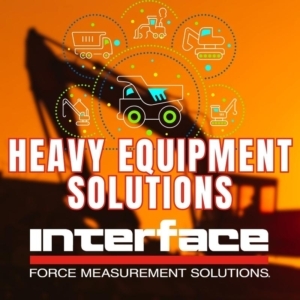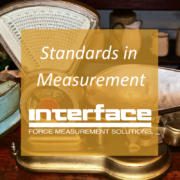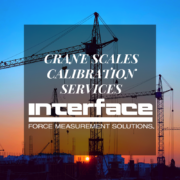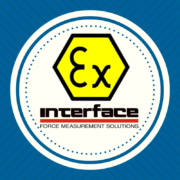Interface Solutions for Heavy Equipment
 Interface has collaborated with heavy equipment design engineers and OEMs for many years by providing sensors to measure weight, torque, and force. Heavy equipment, also known as heavy machinery, is used to describe the heavy-duty machines that are vastly utilized in infrastructure, construction, transportation, maritime, forestry, agriculture, and mining industries.
Interface has collaborated with heavy equipment design engineers and OEMs for many years by providing sensors to measure weight, torque, and force. Heavy equipment, also known as heavy machinery, is used to describe the heavy-duty machines that are vastly utilized in infrastructure, construction, transportation, maritime, forestry, agriculture, and mining industries.
Force measurement plays a crucial role in the design, testing, and use of heavy equipment and vehicles including excavators, bulldozers, loaders, cranes, lifts, mixers, pavers, and compactors. Many of the considerations in designing heavy machinery are mandated by force limitations and equipment performance testing. Reference our Cranes and Lifting case study for examples.
Top Five Heavy Equipment Use Cases for Force Measurement
- Performance Valuation: Force measurement is used to evaluate the performance of heavy equipment. It allows engineers and designers to assess the forces and loads experienced by different components, such as hydraulic systems, structural elements, and moving parts. Measuring forces with high accuracy ensures that the equipment is built to operate within safe and efficient limits.
- Safety Confidence: Heavy equipment operates in demanding and challenging environments where safety is fundamental. Force measurement solutions from Interface help to identify potential safety risks by monitoring the forces exerted on various components in both testing and actual real-time use. Load cells and other sensor technologies enable engineers to design equipment with appropriate safety factors, ensuring that it can withstand the expected forces without failure or compromising operator safety.
- Design Optimization: Force measurement assists engineers to enhance the design of heavy equipment. By accurately measuring forces and loads during operation, and will identify areas of high stress or potential weak points. This information is valuable in refining the design, selecting appropriate materials, and implementing structural modifications to improve durability, efficiency, and overall performance.
- Regulatory Standards and Compliance: Heavy equipment is subject to strict industry standards and regulations, globally, nationally, and locally that specify performance and safety requirements. Force measurement is used for measuring and monitoring compliance. By accurately measuring and documenting forces, engineers can demonstrate that the equipment meets the specified criteria, aiding in regulatory approvals and certifications.
- Troubleshooting and Maintenance: Periodically measuring forces to monitor the condition of critical components and identify any abnormal or excessive forces is useful for identifying issues or wear. This information is critical for preventive maintenance, identifying the root causes of problems, and extending the equipment’s lifespan.
In the construction industry, heavy equipment is extensively used for retail, commercial and civic construction projects. Interface supplies load cells, tension links, load shackles, load pins and other measurement solutions for testing and monitoring.
Excavators are equipped with a hydraulic arm and a bucket, allowing them to dig, excavate, and move enormous amounts of earth, debris, or materials. Sensors are used in design, performance monitoring and maintenance of this type of machinery.
Loaders are powerful machines used for loading materials onto trucks, stockpiling, and general material handling. Overloading is the most common failure. Testing loads for these machines used in construction sites, quarries, and mining operations ensures safety and compliance.
Bulldozers need to be evaluated for earthmoving and grading projects. Rigorous force measurement evaluations help to validate power and maneuverability.
Cranes extensively utilize sensors, including load pins and tension links. During crane lifting capacity tests, force sensors are used to verify if a design for the crane can handle the loads it is required to lift and carry while in movement. This can be done with a variety of different force sensors. Interface tension link sensors are a smart choice as it can be used inbetween the crane hook and the load to provide a more accurate reading on the force. This example of force testing is critical to not only moving the required load, but also in verifying that the crane is safe to operate around workers below. If the crane lift capacity cannot be verified, individuals below the crane are at risk of massive loads dropping from great heights.
Lifts depend on sensors. In the shipping and transportation industry, heavy equipment must have carrying capacities verified or the machines and vehicles may break down or lose control due to excessive loading. In addition, operators need to be cognizant of their load limits and current use in cases. This verification is done using load cells in the testing of the vehicle, but load cells are also used at truck stops with weigh stations. Interface load cells can provide fully accurate data at extremely high weight. In addition, the engines on these trucks need to be able to move the vehicle while under large loads. For this challenge, torque transducers can be used to evaluate and refine an engine’s capability to move vehicles at required loads.
Interface sensors are used in the test and monitoring of maritime heavy equipment, both onshore and near-shore. Cranes and forklifts used in moving cargo plus maritime equipment used for securing lines often use sensor technologies. We also supply measurement devices used for heavy equipment that is submersible. This includes engine testing, mooring and fishing lines, boat hoists and more. Interface offers a complete lineup of sealed sensors that excel while submerged, allowing maritime users to test equipment in real time.
Included below, we have outlined a few heavy machinery testing examples in which Interface products were used:
Gantry Crane Weighing
Gantry cranes are used for several mobile and lifting applications within industrial or construction environments. A weighing system is needed to see if the gantry crane can manage lifting heavy containers or loads, preventing crane failure or accidents. Interface’s WTSLP Wireless Stainless Steel Load Pins can be installed into the corners of the lifting mechanism of the gantry crane, where heavy loaded containers are lifted and moved. The force results are then wireless transmitted to both the WTS-BS-1-HS Wireless Handheld Display for Single Transmitters, or directly to the customer’s PC with the WTS-BS-6 Wireless Telemetry Dongle Base Station. Using this solution, a customer can monitor the loads lifted from their gantry crane with Interface’s Wireless Telemetry System and determine whether their gantry crane was able to manage lifting heavy loads.
Overall, force measurement provides valuable insights into the performance, safety, and reliability of heavy equipment, enabling designers, manufacturers, and operators to make informed decisions and ensure efficient and safe operation.
We have a wide range of solutions for the design and testing challenges of heavy equipment used for lifting, weighing, and measuring force and torque. Contact us for any help you need with heavy equipment solutions.
ADDITIONAL RESOURCES
Infrastructure Projects Rely on Interface
Heavy Truck Test and Measurement Solutions
Force Measurement Solutions for the Construction Industry
Bridge Construction Wind Monitoring
Solutions to Advance Agriculture Smart Farming and Equipment
Why Machine and Equipment Manufacturers Choose Interface
LIFTING: Lifting Heavy Objects








